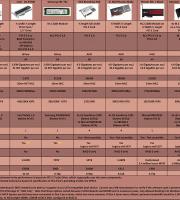


Synthetic tests demonstrated performance boosts of roughly 30-35% across the board relative to the GTX 980 and 70% when compared to a standard Titan.
In the 3dMark 11 performance benchmark, the card racked up a graphics score of 22850, besting its slighter variant by 35% and extracting a commanding 65% margin over its non X rated senior. The Extreme benchmark yielded 7457 marks, which converted to slightly smaller but still notable gains of 26 and 61% for Big Daddy Maxwell .
Figures were even more jaw-dropping for the monumentally merciless Firestrike, with the Titan X scoring 17550 in the standard benchmark, dominating the Titan “Vanilla” by an astonishing 76%, and adding 36% to the 980’s already commendable total. In the Extreme test, the GM200 was one again imperious, calmly carving out leads of 38 and 70% over the 980 and Titan respectively, owing to an astonishing score of 7867 .
The R9 290X was 60% slower on average, but it’s doubled up derivative, the r9 295×2 convincingly turned the tables in all four tests and maintained a mean advantage of 18% over Nvidia’s latest and greatest.
In the gaming stakes. A high intensity, optically candified interval of Crysis 3 saw the Titan X trail the 295X by a shade over 40% at 1440p (2560×1440) and 30% at 2160p (3840×2160). The 290x and 980 were tied, a further 35% behind on average for both resolutions, while the plain old Titan proved 50% slower than its spiritual successor. For each iteration, 4X MSAA and “Very High Settings” were selected in the game’s menus.
The Titan X’s frame rates were less then stellar, hovering around 40fps at 1440p and a decidedly sluggish 2ofps when moving up to 4K, not by any rational standards conducive to a pleasurable rampage. Dropping to the “High Quality” profile boosted speeds to a touch over 40fps, matching those at “Very High” for 1440p, a substantial increase, but still some distance off the elite contingent’s ‘ magic target of 60.
The infamous Shadow of Mordar, a supercharged RPG reputed to devour more memory than a masonic initiation ceremony, forced the Titan X to settle for silver for a third time, 20% behind the 295X at 2160p and 10% at 1440p. The 980 and 290X were left 35% further afield in both high and low runs, while the honourable lord Titan failed to get within 60% of its Maxwell derived descendant. The “ultra” quality option was applied for each loop of the game’s built in benchmark and the Titan X was able to maintain a far more acceptable 50fps at 2160p and a bullish 85fps when descending to 1440p.
Minimum frame rates told a different story, and one which vividly illustrated the growing importance of what many seasoned Steamers had dismissed as an excessively hyped commodity, that of V-RAM. Thanks to its colossal reserves, the Titan X topped the charts at 2160P, over 60% ahead of its closest rivals, the R290X and Titan, a commendable showing from the ancient one.
The 980 slipped to third place, some 70% adrift while the 295X, doubtless owing to crossfire complications, was relegated to the rear and over 100% down on the head of the pack. At 1440p, the titan X reasserted its dominance, but by reduced margin of 20% relative to the 980. Grand master Titan took third, 37% in arrears, the 290X fell to fourth, 60% behind and the 295X, again a victim of its own duality, was over 300% off the pace. It’s highly probable that this anomaly was precipitated by micro-stutter, the common and confounding curse upon any configuration comprising more than one GPU.
Though statistically troubling, these pronounced “troughs” may well not have tarnished perceived fluidity to the degree they would have done prior to AMD’s diligent and profitable driver optimisations.
Finally we come to Battlefield 4, the monstrous military primary perspective blast feast, notorious for its sick desire to wring the coils of robust graphics subsystems until they whine in woeful agony. First across the line at 2160p was the 295X , 19% ahead of the Titan-X, while dropping to 1440p saw this lead sustained. The 980 placed third in both tests, 35% slower than it broader brother while not a solitary pixel separated our noble Titan of the old world from the 290X, each of which was eclipsed by 65% of Big Maxwell’s mighty shadow. With the Ultra quality profile activated at both resolutions, the Titan X ‘s raw pace was its most impressive yet, delivering averages of 60 fps at 4K and 80fps at 1440p, enough to appease all but those insistent on the silkiest action and negligible latency.
And that my comrades was largely the order of the day. Monsieur Vesuvius, still champion overall and by between 25 and 30%. The Titan X, An emphatic singles winner, 30-35% better off than a 980 and 40% more productive than an R9 290X. Ice cool under pressure, quiet as a soft summer breeze, and by all accounts, more tunable than a dragster on propane. Core speed boosts ranging from 300-400mhz were not uncommon while memory frequently granted a bonus of 1000mhz.
Yet, once a redoubtable radial fan had ceased its hushed aria, and 8 billion transistors had entered a state of redemptive tranquillity, had Nvidia make good by its pledge of a solo powered card that could undergo the rendering rigours of Ultra HD and emerge with a trace of dignity? Was Old Green Eyes’ prophecy approximately correct? At the risk of welding myself to a silicon fence, I must respectfully decline to answer since ultimately, the concept of what constitutes adequate playability will always be governed by the wealth of individual experiences and opinions shared outside the walls of a commercial exhibition, and a good thing too.